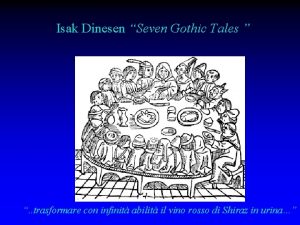Hirayama Disease S Hirayama Disease S Aka Juvenile











- Slides: 11

Hirayama Disease S

Hirayama Disease S Aka Juvenile Muscular Atrophy of the Distal Upper Extremity S Rare disease that affects predominantly males in their 2 nd or early 3 rd decade of life S Features include muscular weakness and atrophy in the hand forearm S Brachioradialis muscle is spared, therefore the pattern of forearm involvement is referred to as an oblique amyotrophy S Unilateral involvement vs asymmetric and symmetric bilateral involvement

Hirayama Disease S Insidious onset and clinical course is steadily progressive S After a period of initial deterioration, a stable stage is reached S Pathogenesis is constantly debated. S Dynamic compression of the spinal cord felt to be an important finding in the diagnosis

Hirayama Disease: Pathogenesis S Dynamic cord compression during neck flexion with forward displacement of the posterior dura is an unequivocal finding in the progressive stage S However, this finding is absent in older patients who have reached a stable stage S Some believe that a disproportional length between the vertebral column and the dural canal leads to a “tight” dural canal.

Hirayama Disease: Pathogenesis S The normal cervical dura is slack and consists of transverse folds during neck extension. S With flexion, the length of the cervical canal increases S In normal patients, the dural slack compensates for the increased length in flexion S Patients with Hirayama dz may have an imbalance in growth of vertebrae and dura, and the short dural cannot compensate; therefore, the dural canal becomes tight when the neck is flexed. S Results in an anterior shift of the posterior dural wall, causing spinal cord compression

Hirayama Disease: Pathogenesis S The pathogenesis of cervical myelopathy may be ischemic changes or chronic trauma with repeated neck flexion. S Compression may cause microcirculatory disturbances in anterior portion of the cord, leading to necrosis of anterior horns S Changes are often greatest at C 6 vertebral level S Primarily affects the anterior horn cells, and in later stages of the disease, spinal cord atrophy ensues. S Some autopsy studies report ischemic changes in the anterior horn cells, with asymmetric cord thinning.

Hirayama Disease: MR findings S Flexion-extension images demonstrate forward migration of the posterior wall of dura S Posterior epidural space enlarges with flexion and is seen as a crescent of high signal on T 1 and T 2 images S Likely reflects congestion of posterior internal vertebral venous plexus S Uniform enhancement of epidural space with contrast S May have flow voids in epidural space S Compressive flattening of the spinal cord with forward shifting of the posterior dura.

Hirayama Disease: MR findings S Spinal cord flattening is asymmetric in majority of cases. S This is an important finding on routine nonflexion MR images and should raise the suspicion. S Spinal cord atrophy limited to the anterior horn cells found in later stages of the disease. S Morphologic changes on MR images correlate well with clinical and electromyographic data

Hirayama Disease Two flexion T 1 post Gd images show increase thickening of posterior epidural space (arrows) which enhances and contains flow voids.

Hirayama Disease Axial T 1 post Gd images in same patient show thick epidural space, particularly posteriorly, compressing the spinal cord.

Hirayama Disease: Treatment S Avoidance of neck flexion can stop the progression of the disease S Some advocate application of a cervical collar for 3 to 4 years since the progressive stage usually ceases in a few years. S Surgical intervention, including cervical decompression and/or fusion with or without duraplasty, may be an option.





















